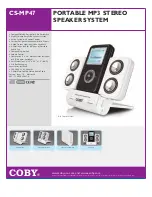
Wiring
Audiobahn recommends using at least 18-gauge wire with your new speaker system. Thinner gauge wire may
easily be severed and can cause damage to your system should any bare wires come in contact with the
vehicles chassis.
Makes sure that your audio system is off while installing and connecting your new Audiobahn Speakers.
Failure to do so could result in damaging the speaker beyond repair. This is not something that would be
covered under the manufacturer warranty.
Be sure to route the wires to the speakers with the insulated terminal ending at the speaker. This will insure a
good contact with the speaker. If you need to shorten the speaker lead, do so on the opposite end of the
insulated terminals or the bare end.
Be sure the polarity is correct at all times. The speaker leads are color coded for negative and positive. Make
sure that the leads connected to the positive terminal of your amplifier or source unit is correctly connected to
the positive terminal of the speaker.
To insure long-term reliability all bare wires and wire-to-wire connections should be soldered and insulated
with heat shrink or electricians tape. Under no circumstances should you leave any bare wires uncovered, as
this can and will lead to the failure of your speakers and possibly other components.
When mounting in a door it is imperative to have the right amount of slack in the connecting wire as to not get
crimped or torn when the door is opened or closed. Avoid areas of the door jam that pinch. This will cause
damage to the speaker and other components over long-term use.
Once the speaker wiring is complete, you can connect the opposite end to the amplifier or source unit. Again,
be sure to observe correct polarity. Solder and wrap all stripped connections.
Wiring
9
Securing the Speaker
Once you have tested your system and confirmed that it is operating properly, turn off your system and
prepare for the final mounting of the speakers.
�
1) Position the speaker into the mounting hole and confirm the correct mounting location and hole �
�
placement. Screw clips are provided to insure a snug fit. Place crew clips over the metal surface �
�
and line up the hole with the hole you have previously drilled. Place the speaker into the hole. Align �
�
the mounting holes and proceed to insert the screws. Be sure to tighten the screws evenly as �
�
not to warp the speaker frame.
�
2) Turn your system back on to confirm the speakers proper operation. First test at low volume and �
�
then you may steadily increase the volume as desired
�
3) The next steps will aid in the proper mounting of the speaker grills. Follow these steps carefully �
�
and be patient. First, locate the special bonding rubber which is located between the wax paper in �
�
the hardware package.
�
4) Carefully inspect the mounting ring where the grill will be inserted. You will notice 4 to 6 ��
�
channeled areas. This is the area where the bonding rubber will secure the grill to the speaker.
�
5) Break off pieces of the bonding rubber that correspond to the size of the channels and insert it �
�
snugly in �place. Once all of the channels have been filled, carefully insert the grill and press firmly �
�
into place.
Warning
�
Securing the Speaker
10
It is extremely important that the mounting ring is correctly installed around the speaker. You may
notice differences in the inner shape of the grill. These cutouts are so the bridges holding the
tweeters and or mids do not touch. You should be able to see the bridge unobstructed when the
ring is mounted.


































